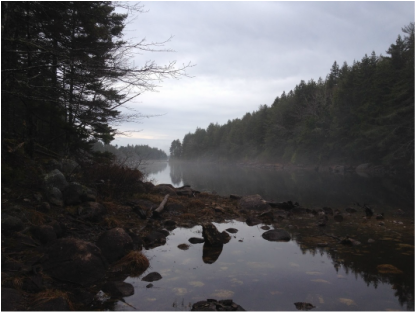|
As long as we're talking about better ways to make electricity than clearcutting, this 2014 blog by Peter Ritchie is interesting. He begins...
You can pay now and play later OR you can play now and pay later. Either way, you have to pay. − John C. Maxwell I think Mr. Maxwell might have borrowed liberally from the FRAM oil filter slogan of the 1970s when he made this remark. Regardless, I have a lot of respect for this sentiment and I believe it is a notion that often goes unheeded in North American society. Allow me to illustrate its intent with a personal anecdote… By the spring of 2011, I had become painfully aware that I, personally, needed to do something to shelter myself and my family from the impending energy crisis we currently face and the worsening effects of climate change. Not only was the federal government of the day failing to act on renewable energy opportunities and climate change, but actively stifling alternatives to dwindling fossil fuel supplies and ignoring the reality of climate change. So, after much research and soul-searching, my wife and I decided to invest in the PV solar system detailed here. We made this decision based not only on a moral principle but on a solid financial argument. It had to be, as we did not have the money to fund this project independently and, therefore, needed to re-mortgage our home to pay the capital cost. I prepared a financial proposal for our mortgage holder (Bergengren Credit Union), which was approved on the spot, based on the facts I had presented. So, off we went on our solar odyssey and, in September 2011, we started collecting and using our own energy from the sun to power and heat our home. The first year passed and everything worked just as predicted. We produced half of the electricity we used that year, at a price (13.8¢/kWh), just slightly higher than that charged by NSPI at that time (13.3¢/kWh). In other words, for that first year we paid about a half a cent premium for the electricity collected by our system. Not bad, right? We figured the extra money we spent that year (about $50) was money well spent on the health of the planet. Something interesting happened on that first anniversary, however. I felt I had somehow fallen short of doing my part to help mitigate climate change. I thought, “Well, producing half of our electricity is okay but…what if we could produce 100% of our electricity? How cool would that be?” Well, we had already “maxxed out” the amount of PV we were allowed to install, so the challenge became, “How to live within the constraints of our solar infrastructure?” Again, after exhaustive research, I discovered that we Canadians are the most wasteful consumers of electricity in the world, while paying the least for this electricity of any country in the world (see: Lindsay Wilson). It turned out that by monitoring our usage and employing some easily attained conservation measures, we were able to reduce our consumption to the point where, since 2013, our PV system has produced all the electricity we have used at our home (with a little left over, each year, to sell to NSPI!). Again, not bad, right? Well here’s the real treat: we will continue to produce our own electricity, at 13.8¢/kWh, for at least the next 20 years while NSPI is currently charging almost 16¢/kWh (with another rate hike expected in the new year). That’s right, for every future NSPI rate increase (averaging 5%/year over the last ten years), we will be saving that much more money on future electricity costs. Our system will have paid for itself in about 10 years from now and will then continue to provide us with “free” electricity afterwards, while still having ten years of warranty remaining on all major components of the system. In the spirit of the opening quotation, I would characterize what I have done as paying now and playing later. We will all have to pay, one way or another, for the energy we use now and into the future. In essence, I have chosen to pay now, as I find the future difficult to predict. Everybody has to make their own choices for their own reasons. This story is meant to explain some of the choices I’ve made regarding the costs of energy. by Peter Ritchie guest blogger
0 Comments

In 2014-15 Nova Scotia Power upgraded their early 20th century Indian River hydro-electric system and among many other improvements installed a $4m fish ladder on their Sandy Lake dam. Archaeologists jumped at the chance - a golden low water opportunity. There they found 6,000 year old aboriginal camp sites. Clearly, connecting the province's interior with St. Margaret's Bay and the ocean, the Indian River system has been a vital transportation corridor for millennia.
Not far from where this magical picture was taken, midst three small protected areas, is the historic Old Annapolis Trail built by Queen Victoria's own father to connect the new British garrison of Halifax with the old French capital, Port Royal near Annapolis. A couple of miles from the burgeoning Tantallon Crossroads where a half-million tourists pass annually on their way to Peggy's Cove, in the middle of a vibrant recreational node for hikers, kayakers, four-wheelers, hunters, fishers, nature lovers of all stripes, the lower Indian River with its mystical lakes and old forests - a magnet for the people of St. Margaret's Bay for generations and now for the thousands of newer residents in the growing communities along the Hammonds Plains Road. Here is where the Nova Scotia Department of Natural Resources in their wisdom, thumbing their noses at public opinion, have announced massive clearcuts. Clearly the Department is much better equipped to determine highest and best use than those who actually live here. Heavy logging they say, buzz 'er off, and this on the very doorsteps of those who might see a markedly different future unfold for these lands. Attached, a letter from the people of the Bay announcing their intent:
Working with a group of new video makers, veteran Antigonish filmmaker Peter Murphy, with noted NS naturalist Bob Bancroft, and Guysborough Country, NS forester Danny George, opens up the issue of clearcutting NS forests to generate electricity. Forest biomass must be de-listed as a renewable resource.
The HFC is grateful to Peter Murphy for letting us post his video. Making movies can be expensive. Peter is planning more videos on NS forestry. Any help you could give to these efforts would be gratefully received via his website, http://www.seabrightproductions.ca/.
In 2001, Genuine Progress Index (GPI-Atlantic), funded by The Nova Forest Alliance, the National Round Table on the Environment and the Economy, the Nova Scotia Voluntary Planning Agency, the Samuel and Saidye Bronfman Foundation, CUSO, the Nova Scotia Public Interest Research Group, and an anonymous donor undertook an in-depth full cost accounting of the province’s forest resource. GPI found a fundamental flaw in our forest management. We rate our success by looking only at the value of the timber we harvest, not, as should be standard practice, by looking also at our principal, the value of what remains. Look what happened to the cod fishery when they barrelled ahead blind to all indicators.
One dramatic indicator, GPI points out, is forest age. In 1958, for example, 25% of the province’s forests were over 80 years old. By 2001, that figure had plummeted to less than 1%. Same for species diversity, devastating declines while timber volumes and clearcuts ballooned. These numbers are invisible when all you look at is half the equation, say, the GDP. Fifteen years ago GPI told us our forests store 107 million tonnes of carbon, saving $2.2 billion in climate change damage. Harvest practices had reduced our forests’ carbon sequestration capacity by 38%, a cost of $1.3 billion. Fifteen years later, those kinds of numbers still don’t show up on our balance sheets. In Volume I of GPI’s massive 2001 two-volume report, they make recommendations which are just as pertinent today as they were fifteen years ago. Small woodlot owners know, we have to rejig silviculture funding to incentivize uneven-aged management and species diversity. Clearcuts and even-aged monoculture is a dead end. We need a gradual shift from a volume-based industry to a value-added one, to increase the number of jobs per unit harvested. We have to protect old-growth forest. We need to count and track annually “the full range of forest values and services, and the full cost and benefits of associated harvest methods.” And, we must plan long term accordingly. Volume II, highly recommended reading, was funded again by the National Round Table on the Environment and the Economy, and by the Nova Scotia Voluntary Planning Agency. It looks at six fascinating case studies which could provide us with some extremely useful alternative models:
Volume II ends with a frustrated effort to fairly assess the job loss/gain from forestry. Negotiating the stats maze ends up inconclusively, but there is an illuminating profile of the bigger is better trap forest contractors continue to find themselves in fifteen years later. Mills pay as close to the harvesters’ breakeven point as they can. To pay for their machines contractors have to work day and night 7 days a week to carve out a modest, high risk, mortgaged-to-the-hilt existence. “The current market structure,” GPI reports, “is geared to the needs of industrial forestry and its dependence on heavy machinery, rather than to selection harvest techniques on smaller woodlots.” Sound familiar? Has anything changed? No. It’s just gotten worse. In its 2008 update, funded by the Province of Nova Scotia, the Alerce Trust, Bill and Susan van Iterson, and members of GPIAtlantic, again the recommendations read like marching orders for the HFC. For our forests to perform their natural functions, like protecting soils, watersheds, biodiversity, carbon sequestration, habitat, and providing high quality timber, we must work to restore age diversity. We need more selection harvesting, more value added production, more value per unit of biomass harvested, and more jobs for rural Nova Scotian communities. All Crown land should be Forest Stewardship Council (FSC) certified, not just a small percentage as was the case. The current government actually just removed all Crown land from FSC certification, deemed by many to be a profound step backwards. We wish we could say same old same old, but in fact things are getting worse, fast. Below are the three GPI reports. In addition to serving an industrial agenda, they apply full cost accounting to their analysis of the province's forests. The reports represent what could have been. They represent good science and good economics and are what the people of Nova Scotia called for repeatedly in the public consultations which followed in the years leading up to the province's Natural Resource Strategy. They make good reading:
The Voluntary Planning document, Our Common Ground, was divided up into five subject areas; Sustainability, Diversity, Collaboration, Transparency, and Informed Decision Making.
In Sustainability a phrase often repeated since then was coined: "The status quo is not an option." It said then current practices were not sustainable. "Our resources and the communities that rely on them are in decline." Sound familiar? The people recognized the overwhelming importance of biodiversity. They said the short term was eclipsing the long term. They emphasized the connection between healthy forests and clean soil, water, and air. They called for green forest practices and the promotion of more value-added forest products.
More than 90% of the Crown forest leased by the Nova Scotia government for harvest is licensed for clearcut.
That’s right, 90%. But, the province’s Natural Resources Strategy, The Path We Share, a dubious title, clearly states that the percentage of clearcutting is to be reduced to no more than 50% by 2016. That’s this year. Now. So how does this work? 90%. 50%. Don’t ask the Healthy Forest Coalition for an explanation. Ask the Minister of Natural Resources, the Honourable Lloyd Hines.
Sometimes we may forget what it's all about...
Precious as jewels, fleeting as snow-flakes, yet ancient as the forest itself, these are the wildflowers of the Acadian forest. The trillium, the spring beauty, the bloodroot and lady slipper, once as abundant as the songbirds - now driven to the far recesses of their range. A priceless inheritance many Maritimers may never see, truly, the Treasures of the Old Forest. Take a look, "Treasures of the Old Forest"... 
Our soils are starved.
Forest soils over 50 per cent of our landmass are losing more nutrients than are being replaced by rainfall or natural weathering of rocks. Think acid rain. Our soils are shallow; they lie on slate, granite and felsic bedrock, and have no buffering capacity against industrial acid rain. Southwest Nova Scotia is in the worst shape. Now think clear-fells. Clear-cutting worsens the effects of acid rain by increasing nutrient losses. Remove wood and bark, stems and stumps and the land is laid bare – open to erosion and further leaching. It’s a no-win situation. No climate issues, no food production concerns – whether sustainable agriculture, denuded energy resources, runaway climate change – can be fixed without addressing the issues of forest health because forest soils are the foundation for everything. And that’s the thing. Our forests have a far higher and longer-term value than the crude market price placed on them by government. Productive soils, clean air, clean water, our social and economic well-being: all derive from healthy forests and a healthy forest floor. We need vision to sustain them, not the short-term asset stripping we see everywhere. Biologist David Patriquin outlines the dismal story in this article from the Chronicle Herald. Briefly:
The price paid in the aquatic realm began upstream. Salmon, brook trout, loons, sugar maple, salamander, songbirds: the losses are too high. The points of the ecosystem triangle – complex interactions between soils, forests and the wider environment – no longer match up. Stay the course and the future is grim. Heed the science and at least we have a chance. |
Blog Archives
October 2020
Blog Index
All
|
Photo used under Creative Commons from DaveW99999





















 RSS Feed
RSS Feed
